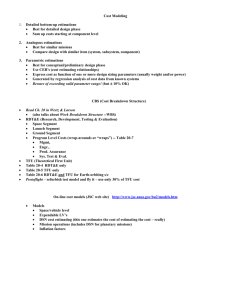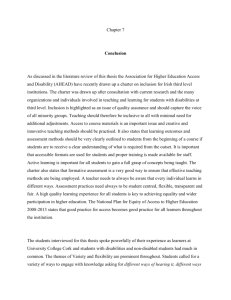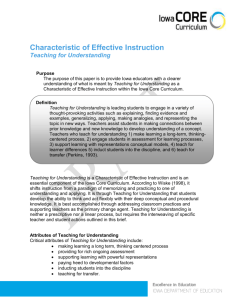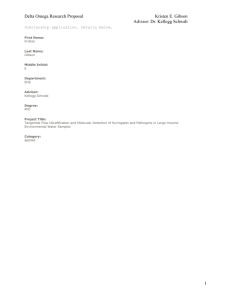Economics 201 Fall 2010 Introduction to Economic Analysis Jeffrey
advertisement
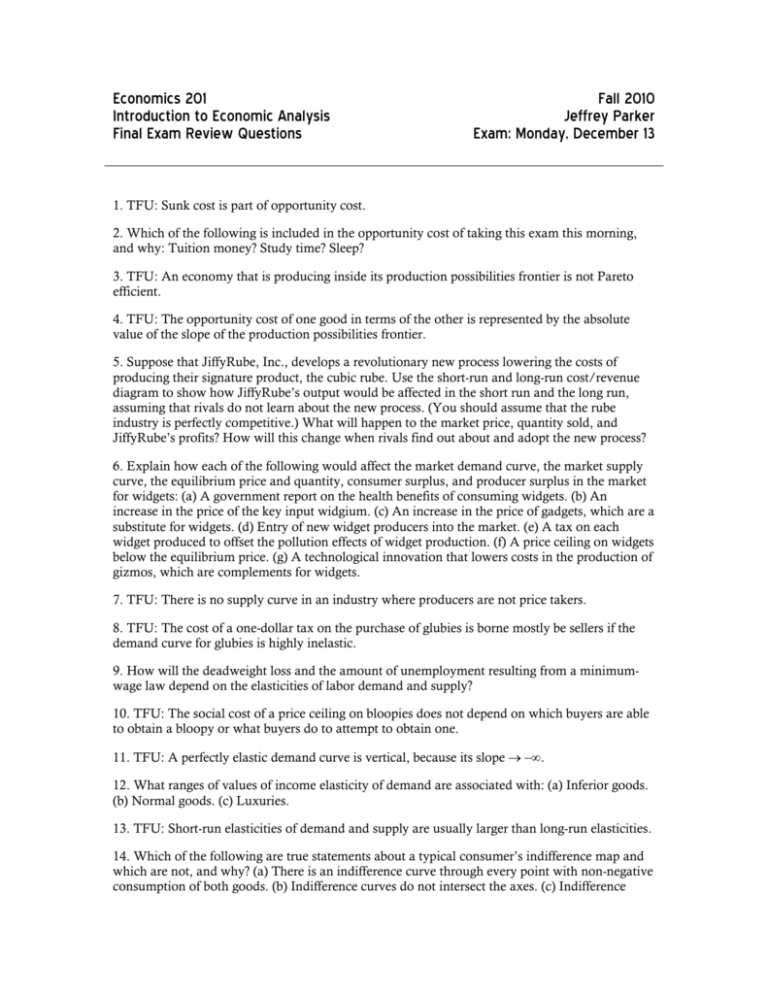
Economics 201 Introduction to Economic Analysis Final Exam Review Questions Fall 2010 Jeffrey Parker Exam: Monday, December 13 1. TFU: Sunk cost is part of opportunity cost. 2. Which of the following is included in the opportunity cost of taking this exam this morning, and why: Tuition money? Study time? Sleep? 3. TFU: An economy that is producing inside its production possibilities frontier is not Pareto efficient. 4. TFU: The opportunity cost of one good in terms of the other is represented by the absolute value of the slope of the production possibilities frontier. 5. Suppose that JiffyRube, Inc., develops a revolutionary new process lowering the costs of producing their signature product, the cubic rube. Use the short-run and long-run cost/revenue diagram to show how JiffyRube’s output would be affected in the short run and the long run, assuming that rivals do not learn about the new process. (You should assume that the rube industry is perfectly competitive.) What will happen to the market price, quantity sold, and JiffyRube’s profits? How will this change when rivals find out about and adopt the new process? 6. Explain how each of the following would affect the market demand curve, the market supply curve, the equilibrium price and quantity, consumer surplus, and producer surplus in the market for widgets: (a) A government report on the health benefits of consuming widgets. (b) An increase in the price of the key input widgium. (c) An increase in the price of gadgets, which are a substitute for widgets. (d) Entry of new widget producers into the market. (e) A tax on each widget produced to offset the pollution effects of widget production. (f) A price ceiling on widgets below the equilibrium price. (g) A technological innovation that lowers costs in the production of gizmos, which are complements for widgets. 7. TFU: There is no supply curve in an industry where producers are not price takers. 8. TFU: The cost of a one-dollar tax on the purchase of glubies is borne mostly be sellers if the demand curve for glubies is highly inelastic. 9. How will the deadweight loss and the amount of unemployment resulting from a minimumwage law depend on the elasticities of labor demand and supply? 10. TFU: The social cost of a price ceiling on bloopies does not depend on which buyers are able to obtain a bloopy or what buyers do to attempt to obtain one. 11. TFU: A perfectly elastic demand curve is vertical, because its slope → –∞. 12. What ranges of values of income elasticity of demand are associated with: (a) Inferior goods. (b) Normal goods. (c) Luxuries. 13. TFU: Short-run elasticities of demand and supply are usually larger than long-run elasticities. 14. Which of the following are true statements about a typical consumer’s indifference map and which are not, and why? (a) There is an indifference curve through every point with non-negative consumption of both goods. (b) Indifference curves do not intersect the axes. (c) Indifference curves do not intersect each other. (d) Indifference curves are downward-sloping. (e) Indifference curves are steeper at the top than at the bottom. 15. TFU: If a consumer is a price-taker in the markets for asparagus and cauliflower, then her opportunity set is the interior and edges of a triangle. 16. TFU: Close substitutions will have indifference curves that are nearly straight lines. 17. TFU: If two goods are close substitutions, then it is very unlikely that a corner solution will result. (I.e., the set of relative prices at which a corner solution is optimal is very small.) 18. TFU: The substitution effect can never cause a decrease in consumption of a good whose price declines. 19. TFU: The income effect can never cause a decrease in consumption of a good whose price declines. 20. How will an increase in a consumer’s income affect her budget constraint? How will it affect the optimal consumption of the two goods? 21. TFU: If the marginal utility of an expected-utility-maximizing consumer’s general consumption declines with increases in income, then she will be risk averse. 22. What is the difference between a fixed and a variable factor of production? Is labor always a variable factor? Is capital always a fixed factor? Explain. 23. TFU: The more you feed a cow the more milk she produces, but the more you feed a cow the less additional milk she produces for each pound of additional feed. 24. TFU: The average-cost curve always cuts through the minimum point of the marginal-cost curve. 25. Define the marginal rate of technical substitution. If firms minimize costs, what is the MRTS equal to? 26. If a firm increases its labor input by 20% and its output only goes up by 10%, what (if anything) can we say about the firm’s returns to scale? 27. Suppose that a grupling machine requires exactly one person to operate it and produces 40 gruples per hour. Show the isoquants corresponding to producing 40, 80, and 120 gruples per hour. 28. Suppose that Lois loves pink purses but has no use for blue ones. What will her indifference map look like (with pink on the vertical axis and blue on the horizontal)? Show the optimal allocation of her purse budget. Will the indifference curve be tangent to the budget line? 29. TFU: Sunk cost is not part of fixed cost. 30. Suppose that the real interest rate is 4%, that iBloops cost $3000 each, and that their economic value deteriorates at 25% per year due to wear and tear and obsolescence. What is the equilibrium annual price for which you can rent a new iBloop? Why? 31. TFU: The long-run average cost curve connects the minimum points of all of the short-run average cost curves corresponding to different levels of capital. 32. Define normal profit and economic profit. What determines the rate of normal profit in the economy? 33. TFU: The total-revenue function of a perfectly competitive firm will be a linear function of its output. 34. TFU: A firm in a perfectly competitive industry maximizes its profit where P = ATC in the short run. 35. TFU: A firm in a perfectly competitive industry maximizes its profit where P = ATC in the long run. 36. TFU: A firm in a perfectly competitive industry maximizes its profit where P = MC in the short run. 37. TFU: A firm in a perfectly competitive industry maximizes its profit where P = MC in the long run. 38. Suppose that the LRAC curve of a perfectly competitive industry is U-shaped and that the current industry price is above the minimum level of average costs. Can you tell whether there will be entry, exit, either, or neither? Explain. Can you tell whether firms will expand or contract their scale of operation? Explain. 39. Suppose that the whoople industry is perfectly competitive with constant costs and a Ushaped LRAC. Starting from long-run equilibrium, suppose that the market demand for whooples increases. Use appropriate diagrams to explain what will happen in the long run to the price of whooples, the number of whooples consumed, the number of firms in the whoople industry, and the quantity produced by each whoople firm. 40. Explain why there is a difference in the slopes of the long-run supply curves in a constant-cost vs. an increasing-cost industry. 41. TFU: Producer surplus = profit + fixed cost. 42. TFU: A monopoly firm that pollutes the environment might end up producing the socially optimal amount of output. 43. TFU: The total revenue curve of a monopoly is linear in its output. 44. TFU: A monopoly is producing too little if the price it receives for its product is greater than the marginal cost of producing it. 45. TFU: A monopoly’s marginal revenue is negative when demand is elastic. 46. How does a monopoly producer’s markup (price vs. marginal cost) depend on the elasticity of the demand for its product? What happens to the markup as the monopoly’s market power erodes and it approaches perfect competition? What happens as the (absolute) elasticity of demand approaches one? 47. Show the LRAC and LMC curves for a natural monopoly. Draw in a demand curve and show the points corresponding to profit maximization, break-even, and allocative efficiency. Why is regulation at the point of efficient production problematic? 48. Show the short-run production diagram for a monopoly that makes a profit, including the D, MR, MC, and ATC curves in proper configuration. Identify the profit-maximizing and efficient levels of output, the consumer surplus and profit in both of these situations, and the dead-weight loss associated with the monopoly. 49. How is monopolistic competition like perfect competition? How is it like monopoly? Is production at the efficient point in the long run under monopolistic competition? Is each firm producing at minimum cost in the long run? Are firms earning economic profits in the long run? 50. TFU: The fact that publishers sell identical textbooks abroad for much less than in the United States suggests that the demand for textbooks abroad is less elastic than in the U.S. 51. Use the concept of demand elasticity and the relationship between elasticity and a monopoly’s markup to explain why it might be in the interest of a manufacturer with a monopoly on a particular style of printer to sell printers at a low price but ink cartridges for them at a high price. 52. Using the same argument as in the previous question, is Reed more likely to increase your financial aid due to unusual circumstances at the time you are applying or before your junior year? Why? 53. What do we mean by “strategic interaction”? Why does this occur in oligopoly but not under perfect competition or monopoly? 54. Define an oligopolist’s reaction function and explain what Nash equilibrium means. 55. In a game-theoretic context, it can be optimal to make decisions randomly rather than following a fixed rule. 56. Consider the following payoff matrix between an instructor and his students: Instructor Student Study Not study Hold exam 5, 2 –5, –5 Cancel exam –2, 5 0, –2 Does the student have a dominant strategy? Does the instructor? Is there one or more Nash equilibria? If so, describe the equilibrium outcome. Is it optimal? If the students understand the instructor’s payoffs, can the instructor credibly get them to study? 57. Suppose that there is a large pool of students that choose between Reed and Lewis & Clark, with many choosing each school. Why might it be in Reed’s interest to make itself more like Lewis & Clark if it wants to attract more of these students? 58. Show that for a firm that is a price-taker in both product and labor markets, with labor being the only variable factor, MRPL = W is identical to P = MC as a condition for profit maximization. 59. TFU: The long-run demand curve for labor in a perfectly-competitive constant cost industry is perfectly elastic. 60. Suppose that, at the margin, Cavaradossi likes two liters of wine the same amount that he dislikes one hour of singing. He is maximizing utility and the wage for singers is 10,000 lire per hour. What is the price of wine per liter? 61. TFU: An increase in the real wage will raise the amount of labor a utility-maximizing worker supplies. 62. TFU: Labor-supply elasticity with respect to temporary wage increases is likely to be greater than that with respect to permanent increases. 63. Why might unions choose to push wages above the competitive equilibrium level? What limits their attempts to raise wages? 64. TFU: Unions lower employment in covered industries. 65. List five job characteristics that might affect the wage that will be paid for a particular job, and give examples of jobs in which each might be important. 66. How might one employer motivate employees with an efficiency wage? What happens if all employers pay efficiency wages? 67. Suppose that Reed has issued bonds to be repaid in 2025 and bearing and coupon interest rate of 3.5%. What will happen to the price of these bonds if there is an increase in the supply of loanable funds? Why? 68. TFU: Expected deflation of 5% might lead to chronic excess supply in the market for loanable funds. 69. TFU: A nominal interest rate of 13% is a good return on your money. 70. TFU: Starting from a given point, exchange equilibrium in an Edgeworth box can occur at any point in the “lens-shaped area” defined by the two individuals’ indifference curves that pass through the initial point. 71. TFU: In competitive general equilibrium, all consumers who buy apples and bananas have the same MRS between them. 72. TFU: In competitive general equilibrium, the marginal revenue product of labor is the same in all industries. 73. TFU: In competitive general equilibrium, the marginal cost of production is the same in all industries. 74. TFU: Adverse selection might lead me to stop locking my car if I have comprehensive auto insurance. 75. Use the theory of asymmetric information to explain why it is difficult to find a good used car. 76. TFU: The socially optimal amount of pollution is zero. 77. Suppose that you live in a house with two other people, Xerxes and Xavier. If you decide to buy a television, it will be nonrival and nonexcludable. There are occasional times when it would be useful to have two. Xerxes would be willing to pay $50 for one TV and $55 for two. Xavier would pay $80 for one and $100 for two. You would give $100 for one and wouldn’t ever use the second. At what range of prices should the house buy one TV? Two TVs? 78. Explain Okun’s concept of the “leaky bucket.” What factors determine the amount of leakage that will happen with any given income redistribution program? 79. TFU: GDP is a flow. 80. Why might it be reasonable to assume that an increase in a country’s per-capita real GDP reflects an increase in utility? What would we have to hold constant in order for this assumption to be valid? 81. How (if at all) would each of the following affect the natural rate of unemployment and why: (a) An influx of inexperienced workers into the economy? (b) Rapid shifts in the industry composition of a country’s output? (c) An increase in the generosity of unemployment benefits? (d) Better surveillance technology that makes it easier to detect shirking workers? (e) A decline in the share of workers belonging to labor unions. (f) An increase in aggregate demand. 82. TFU: Long-run improvement in the U.S. standard of living depends mostly on improvements in total-factor productivity associated with technological change. 83. TFU: According to the convergence hypothesis, the U.S. and Mexico should converge to the same level of real per-capita GDP. 84. Explain which of the following is true in a long-run, Schumpeterian equilibrium with R&D spending and ongoing productivity growth (and why): (a) Firms make zero economic profit on their production activities. (b) Firms produce where price equals marginal cost. (c) Resources are allocated efficiently at every moment in time, given the state of technological knowledge. (d) The marginal benefit to entry into the industry is zero, despite firms making positive economic profits on their production. (e) R&D costs balance out economic profits on production. 85. What are the advantages of high appropriability for innovations? What are the advantages of low appropriability? 86. TFU: An increase in the expected inflation rate will not change the equilibrium real interest rate. 87. TFU: If Zebulon gives up looking for a job, that will lower the unemployment rate. 88. TFU: An increase in the growth rate of the money supply leads to faster economic growth in the long run. 89. TFU: An increase in the growth rate of the money supply leads to higher inflation in the long run. 90. The recent “quantitative easing” policy adopted by the Federal Reserve involves purchasing large amounts of long-term government bonds. Explain how these purchases will affect the reserves and deposits of commercial banks. What happens to the monetary base? What will happen to the money supply if banks simply hold onto the money as excess reserves? What will happen to the money supply if banks increase lending? 91. What are the major social costs of inflation? Which of these occur if inflation is correctly anticipated and which result from unanticipated or uncertain inflation? 92. For each of the following, tell whether it would affect aggregate demand or aggregate supply and what effect it would have: (a) An increase in the price of imported oil. (b) An increase in government spending. (c) A decrease in union wage demands. (d) An improvement in productivity due to technological advance. (e) An increase in the expected long-run profitability of capital. (f) An increase in expected future incomes. (g) A depreciation of the value of the dollar. 93. Explain why each of the three theories of short-run aggregate supply predicts an increase in real output when aggregate demand is unexpectedly high. 94. Explain why each of the three theories of short-run aggregate supply predicts that an increase in aggregate demand will not affect output in the long run. 95. TFU: Low inflation can only be attained at a high level of unemployment. 96. TFU: A $100 billion increase in government spending can be expected to raise aggregate demand by more than $100 billion. 97. TFU: A $100 billion increase in government spending would probably raise real interest rates. 98. TFU: Attempts by the government to stabilize the business cycle may do more harm than good. 99. TFU: The lower nominal interest rates go, the more powerful monetary policy becomes.
